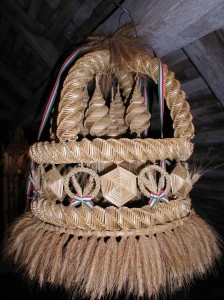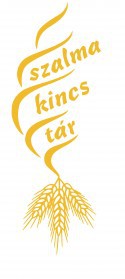English
 Invitation to the Museum
Invitation to the Museum
„Culture cannot be inherited. The culture of our ancestors soon vanishes unless each generation obtains it for themselves.”
(Kodály Zoltán)
The freely available, pliable filamentary materials found in nature have been used by primitive craftsmen and women from a very ancient time. The experience of getting a new plant from the seed got in wet soil – that is growing crops – first became a valuable knowledge of neolite man in 7000 B.C living in the valley of the Nile. As the result of this procedure used to be rather unforeseeable, it is easy to understand why people worshipped their goddess of corn (Isis in Egypt, Demeter in Greece, Ceres in Rome) with such a great reverence. They made a “doll” from the last sheaf in order to preserve life. Till the invention of the plough (appearing in Egypt about 3000 B.C. ) women cultivated earth, so no wonder that these dolls resembled of female figures.
Wheat has always been called “life” by Hungarian farmers, as their well-being greatly depended on it. Apart from the seeds of the crops (wheat, barley, oat, rye, rice, alacor or triticale) its straw, that is, its hollow stem was also used, mainly with every day purpose: laid under animals, bedded clamps, covered roofs with it. Children twisted simple dolls, formed rings while tending animals in the fields. The softness, pliability, velvety shine of straw was used in Japan to make tatami rugs, in France they sewed so called envelopes for transporting wine-bottles or cheese and in many other places dishes for storing eggs, seeds or bread were made from it. During the centuries besides the primary use of straw its decorative texture was also discovered. Plaits and ornamental objects were made for the hat industry in England and Switzerland. Playing and creative men have enriched the use of straw with numerous new ideas, they twisted, interlaced, rolled, tied, flattened, plaited straw – in order to create jewellery, toys, decorations, objects of beauty and even pictures.
The common base of this unique private collection – property of Ms Tünde Tüskés – is the material the displayed objects are all made of: straw. The exhibition invites visitors for a trip of discovery: we can see some 600 objects originating from around 25 countries of the world. By looking at them we may wonder on their makers’ skill, creativity and artistic talent.
The collection opens up a nearly forgotten slice of cultural, historical and antropological heritage of the world. The material put on display is a source of an exciting journey through the past and present, work and art, the national and universal experience of mankind and we can witness its intention to form unity between form and function, mastership and art.
We sincerely hope that you will enjoy this journey!
Come and spend a lovely day in this beautiful village at the foot of Zengő, the highest peak of Mecsek mountain. Enjoy the hospitality of its people and buy some unique gifts in the Straw Treasury Museum!

